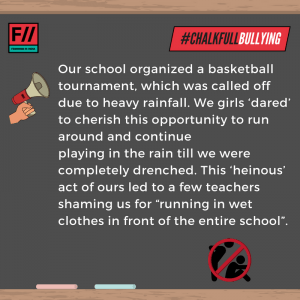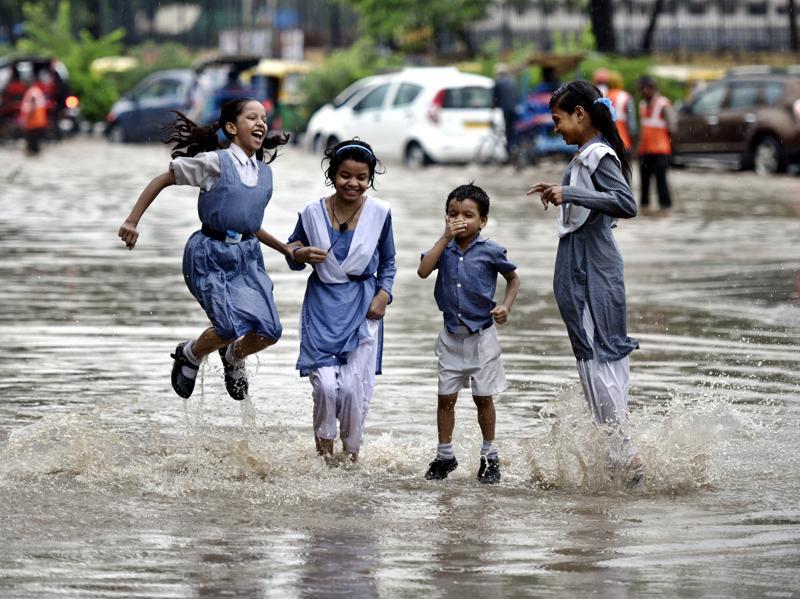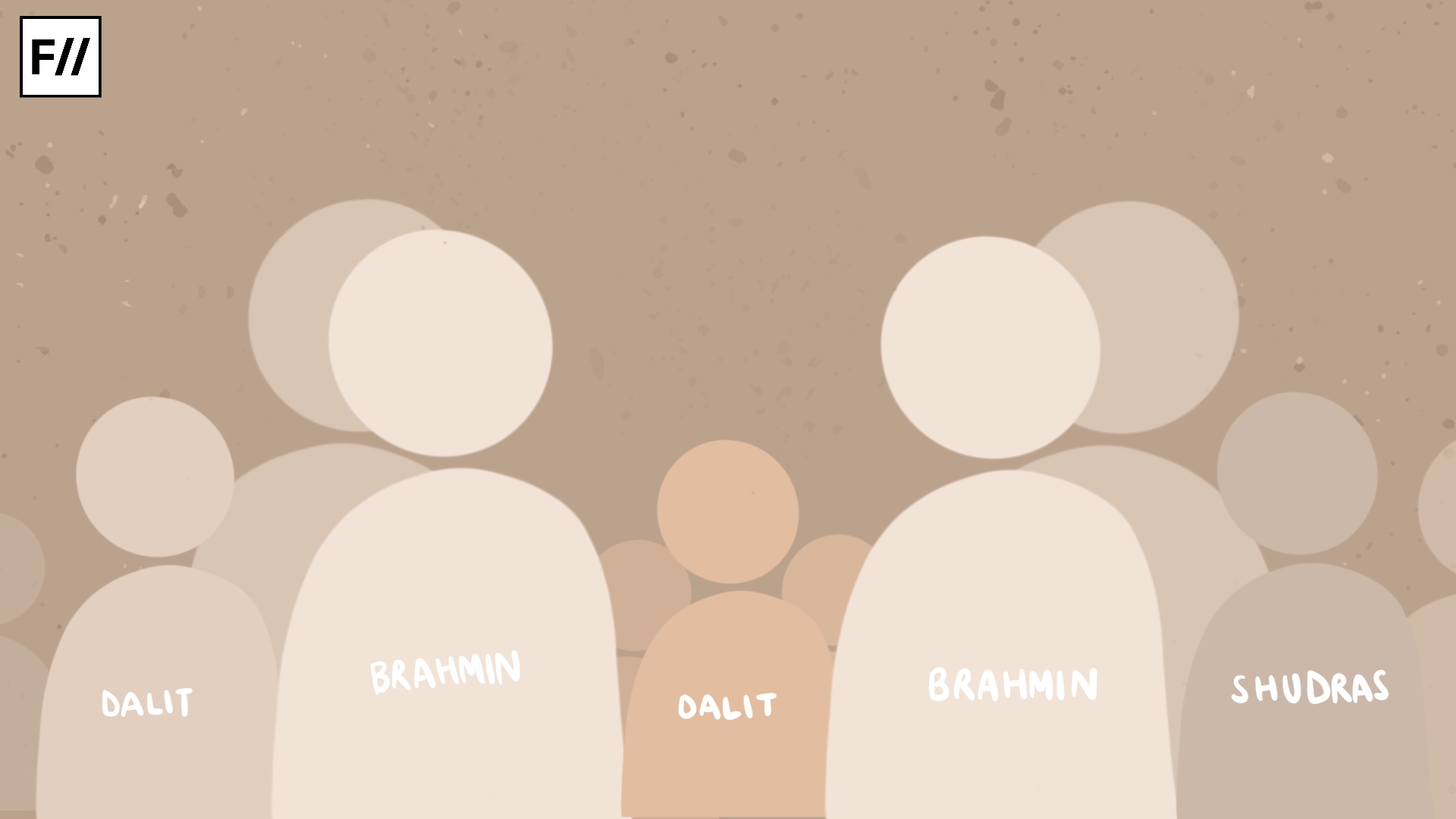Editor’s Note: #ChalkfullBullying is a campaign that resolves to tell stories about gender-based bullying that happens in school, where students, especially non-binary and girl students, are subject to harassment, moral policing, severe disciplining and punishment, and routine bullying. Their fault being: for not conforming to outdated gender stereotypes, the repercussions for which can scar us for a lifetime.
School authorities shaming young school going girls for the way they carry themselves in uniform is not a new phenomenon. But the legitimacy to humiliate often percolates down to students who also grow up internalizing the same values from a very young age.
We have come across several of such disturbing accounts from India and across the world where girls as young as 6 years of age are asked to cover up in school. Young girls are often called out on their appearance and uniform in the name of discipline and character-building, while targeted humiliation is specific to those who are not ‘normal’ boys.

This legitimized humiliation brings our attention to an extremely alarming attitude since it reinforces the same ‘rationale’ that renders women responsible for sexual assaults because they are accused of ‘enticing men’ with their appearances and clothes. Young girls are being taught that how much skin they reveal makes them responsible for what happens to them.
Schools are a crucial space for learning different forms of self-expression, discovering oneself before stepping out into the ‘real world’. But are we breeding the same discriminatory values in school children that could explain the nature of violence that occurs in our everyday? To what extent is it alright to ‘discipline’ girl students which tell them that their ways of wearing their uniform reveal a great deal about their character?
When did it become mandatory to see through our shirts to check that our bra was completely covered by a white piece of extra clothing worn inside the shirt, no matter how humid or extreme the weather conditions? But as long as our bra shape, colour or size is hidden, our modesty remains intact. Who else cares if you are dying of heat stroke?
I have experienced several harrowing experiences in school – where I spent 14 years of my life. Being the captain of the basketball team, my build was bigger than most boys my age. This threatened their fragile formative masculinities so much that they began body shaming me from the age of 14. This was when I first developed an eating disorder.
The phenomenon of name calling remained unquestioned and every student indulged in this practice. The teachers were ignorant of what happened outside their classrooms. My memories from school are hijacked by everyday fear of getting caught and humiliated in front of the entire assembly for reasons as petty as wearing the uniform in a way that called upon shame.
When did it become mandatory to see through our shirts to check that our bra was completely covered by a white piece of extra clothing?
This shame was specific to us girls because it was closely tied to our moral character, our upbringing, our sexuality and our modesty. “You don’t want to prove the entire school that you are that type of a girl” are some of the common phrases we heard growing up.
So much so, that everyday assembly inspections were the longest and most distressing 5 minutes of the day. If you were caught, your parents will be brought to school to further your agony. The entire school would find you kneeling outside the principal’s office.
Humiliation is not a technique that schools should adopt as it often leaves students with lifelong scarring memories. My experience with teachers was not the best, by virtue of the fact that I asked questions and raised objections whenever possible. With growing name calling and body shaming, I preferred wearing my uniform in the way that would cover more than what was required by ‘discipline’, but no teacher could identify this strange behaviour because they assumed I was merely following the rules.
The teachers often pulled a few girls out of class or from assemblies to discuss that their ways of carrying themselves were violating modesty standards that the school demanded. But what is so shameful about women’s bodies? Why were our bodies always the point of contention?
Our school organized a basketball tournament and because of heavy rainfall, the matches were called off. We girls ‘dared’ to cherish this opportunity to run around and continue playing in the rain till we were completely drenched. This ‘heinous’ act of ours infuriated a few teachers who shamed us for “running in wet clothes in front of the entire school”.
Also Read: Gender Stereotypes In My 7th Grade Classroom
Male students learned to normalize shaming young girls and indulged in all forms of bullying. Boys bullied girls for being ‘loose’ and ‘easily accessible’, invoking their sexuality in ways that were beyond humiliating. In 2009, with the advent of social media (mostly Facebook) our social lives changed considerably.
Access to the internet and technology was a double-edged sword – a space free of any constraint. One was free to approach whoever they wished without any form of restriction. While on one hand, we had access to knowledge, possibilities and networks offered by the internet, on the other hand, it could turn into a dangerous platform that consumed a significant part of our lives.
Online abuse became a part and parcel of our everyday. Lack of knowledge about what constitutes cyberbullying and harassment was a crucial problem and many of us faced this when we were first introduced to social media.
In 2009, I met a schoolmate on Facebook and we began talking frequently, which led to meeting in school secretly because we could not be seen loitering with boys alone during recess or otherwise. This was the first time I first developed a different kind of a friendship.
Later, to my surprise, when this friendship soured he took to social media to announce to the world the deepest and most intimate details of our friendship. This led to other boys joining in, almost as if they were huddling in to share their piece of mind on the issue. Soon I found that parts of my body were named and were being discussed online amongst these boys.
Male students learned to normalize shaming young girls and indulged in all forms of bullying.
This aggravated my body image issues to a serious extent. It has been almost 8 years since I graduated and I am still struggling to overcome the same. Post this incident, I indulged in bulimia, exercised 4 to 5 hours a day, developed eating patterns that had some serious ramifications on my body, lost around 15 kgs of weight and developed serious health problems.
The 16-year-old me struggled with these body image issues that defined my self-worth and left me with a general sense of inadequacy, anxiety and a need for validation. The shame that manifests from online bullying felt more permanent and far more personal. It was difficult for me to understand that this behaviour constituted bullying.
My intention in writing this article is not to pinpoint certain bullies or the failure of certain school authorities. It is to address the act of bullying per se that includes both online and offline spaces and most importantly, the crucial role of teachers in ensuring a safe space for students and especially young girls to fight against discriminatory acts of blatant sexism leading to gruesome forms of violence perpetuated on women’s bodies.
Their primary role is to inculcate in students that the way a girl is dressed is never a cause to humiliate her or hold her responsible for other people’s behaviour. The system of upholding the morality of girl students reflected in their modesty, covered bodies and obedient minds in the name of disciplining the students in ways that were never equitably enforced and the burden of the same often fell on girl students.
Why can’t we ensure that all students are encouraged to dress comfortably in their uniform and engage in the educational environment without fear of irrelevant disciplining or body shaming? Lastly, one cannot tell at what point in time did male gaze enrol in our schools and began enforcing power dynamics. I, however, do know that it’s well past time for an immediate change – a shift of responsibility from girls to boys to teachers to school authorities and most importantly, to the system that legitimizes the perpetuation of such discrimination.
Also Read: We Need To Start Discussing Sexual Harassment In The Classroom
If you (or anyone you know) have a story to tell about the gender-based bullying you encountered in school, please email us at info@feminisminindia.com (or on our Twitter, Facebook and Instagram page) and help us continue a conversation on bullying by those in power in schools. Anonymity is ensured.
Featured Image Credit: Hindustan Times




